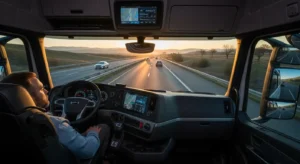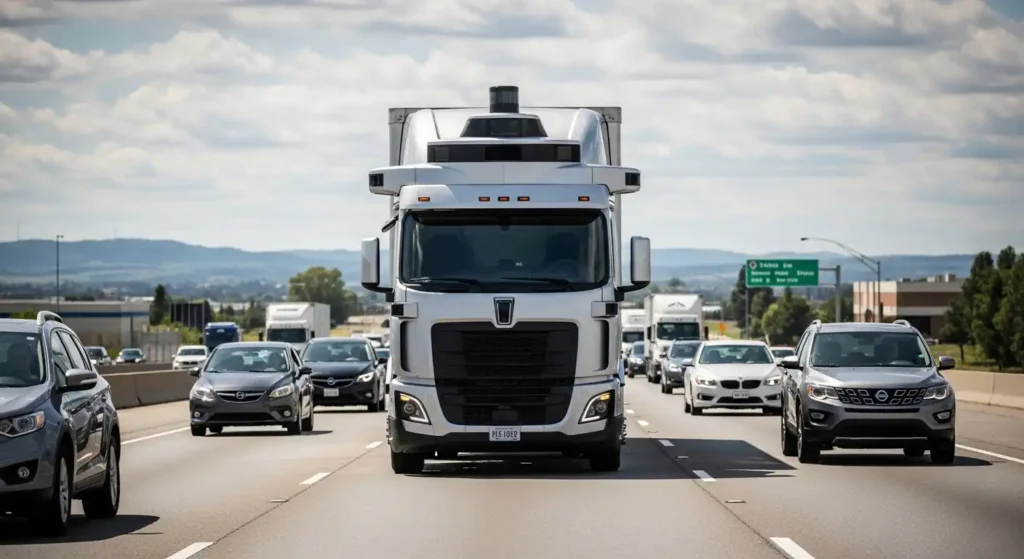Introduction: The Trucking Revolution is Here
 The trucking industry, long dependent on human drivers to deliver goods across the country, is on the verge of a major transformation. Autonomous trucks—vehicles capable of driving themselves without human intervention—are beginning to reshape the logistics and freight industry. These trucks, equipped with advanced sensors, cameras, and artificial intelligence (AI), have the potential to revolutionize how goods are transported, reducing costs, improving safety, and addressing the growing shortage of truck drivers.
The trucking industry, long dependent on human drivers to deliver goods across the country, is on the verge of a major transformation. Autonomous trucks—vehicles capable of driving themselves without human intervention—are beginning to reshape the logistics and freight industry. These trucks, equipped with advanced sensors, cameras, and artificial intelligence (AI), have the potential to revolutionize how goods are transported, reducing costs, improving safety, and addressing the growing shortage of truck drivers.
In this blog, we explore the rise of autonomous trucks, their potential benefits, and the challenges they present. We’ll also discuss what the future holds for this technology and its impact on the trucking industry at large.
The Rise of Autonomous Trucks
Autonomous trucks are no longer a futuristic concept. In fact, they’re already being tested on public roads. Companies like Aurora Innovation, Waymo, and TuSimple are leading the charge in the development and deployment of self-driving trucks. Aurora’s self-driving trucks, for example, have been tested on highways in Texas, delivering freight without a human driver behind the wheel.
The U.S. government has also recognized the potential of autonomous trucking, providing regulatory guidelines and establishing pilot programs to ensure the technology’s safe integration into the transportation network. As the technology evolves, more autonomous trucks will be deployed, especially for long-haul routes that typically require significant driver hours and stamina.
Benefits of Autonomous Trucks
1. Addressing Driver Shortages
The trucking industry has been grappling with a significant shortage of drivers. According to the American Trucking Associations (ATA), the U.S. was short about 60,000 truck drivers in 2019, a number that is expected to grow as older drivers retire and younger individuals are dissuaded from entering the profession. Autonomous trucks can help fill this gap by reducing the reliance on human drivers, particularly for long-haul routes where driver fatigue is a major concern.
2. Cost Reduction
Autonomous trucks can drastically reduce operational costs. By eliminating the need for human drivers, companies can save on labor costs, and AI-driven trucks can optimize their routes to minimize fuel consumption and reduce wear and tear on vehicles. The technology’s ability to operate around the clock without needing rest breaks further boosts efficiency and reduces costs for shipping companies.
3. Safety Improvements
One of the biggest advantages of autonomous trucks is the potential for improved safety. Human error is responsible for the majority of truck accidents, but autonomous trucks, equipped with advanced sensors and AI systems, can eliminate many of these risks. These trucks are designed to be hyper-aware of their surroundings, with the ability to detect hazards, react to changing traffic conditions, and make decisions much faster than human drivers.
Additionally, autonomous trucks can operate in ideal conditions, ensuring that they avoid driving in inclement weather or other dangerous situations. This leads to fewer accidents, less damage to cargo, and ultimately safer roads for all motorists.
Challenges of Autonomous Trucks
1. Regulatory and Legal Hurdles
One of the biggest obstacles to the widespread adoption of autonomous trucks is the regulatory environment. Current laws were written with human drivers in mind, so regulators need to update these laws to accommodate the operation of self-driving trucks. Issues such as liability in the event of an accident, insurance requirements, and safety standards must be addressed before autonomous trucks can be fully integrated into the transportation network.
2. Public Perception and Trust
Another challenge is public perception. Many people are still skeptical about the safety of autonomous vehicles, and this skepticism is even more pronounced when it comes to large trucks traveling at high speeds. The trucking industry needs to work to build trust in the technology, highlighting its safety features and showcasing successful real-world trials. Public education campaigns will also be necessary to ensure that drivers on the road are comfortable sharing the highway with autonomous trucks.
3. Technological Limitations
While autonomous trucks have made significant progress, there are still technological limitations that need to be addressed. For instance, self-driving trucks may struggle in certain weather conditions, such as heavy rain or snow, which can impede visibility. Additionally, while sensors and AI systems are improving, there are still scenarios in which a human touch may be necessary to make complex decisions, especially in unusual or dynamic traffic situations.
The Future of Autonomous Trucks
 Despite the challenges, the future of autonomous trucks looks promising. Over the next decade, we can expect to see increased adoption of self-driving trucks in specific sectors of the freight industry, particularly for long-haul routes and deliveries between distribution centers. As the technology becomes more refined and regulatory frameworks are updated, autonomous trucks will play an integral role in the global supply chain.
Despite the challenges, the future of autonomous trucks looks promising. Over the next decade, we can expect to see increased adoption of self-driving trucks in specific sectors of the freight industry, particularly for long-haul routes and deliveries between distribution centers. As the technology becomes more refined and regulatory frameworks are updated, autonomous trucks will play an integral role in the global supply chain.
However, the rise of autonomous trucks also means that the trucking industry must adapt to new realities. While some jobs may be lost, new opportunities will be created in areas like truck maintenance, AI programming, and data analysis. It will be essential for the workforce to undergo retraining and upskilling to meet the demands of a more automated industry.
As the road ahead for autonomous trucks becomes clearer, one thing is certain: the trucking industry will never be the same. The innovation brought by autonomous trucks is expected to create a more efficient, safer, and cost-effective freight transportation system for the 21st century.

